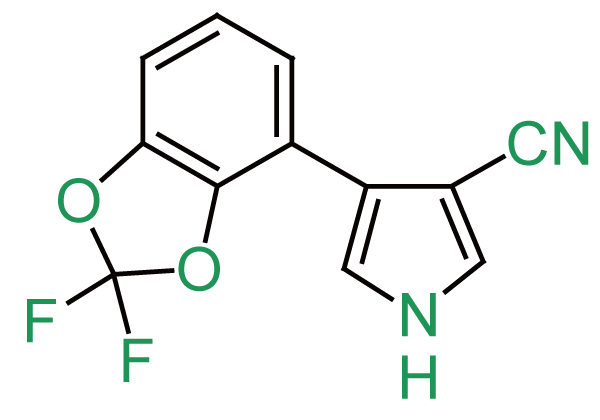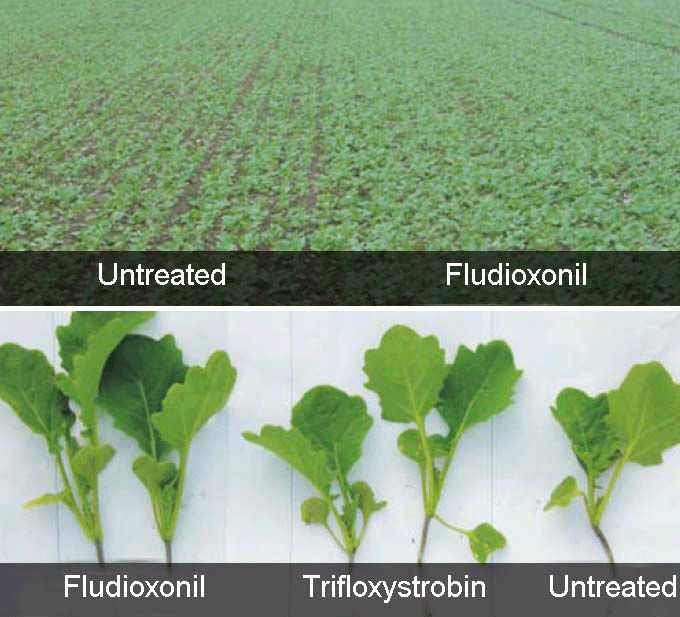- Azoxystrobin
- Bitertanol
- Captan
- Carboxin
- Carbendazim
- Cymoxanil
- Cuprous Oxide
- Copper Hydroxide
- Cyproconazole
- Cyprodinil
- Dimethomorph
- Diniconazole
- Difenoconazole
- Epoxiconazole
- Fluazinam
- Fludioxonil
- Fosetyl-aluminium
- Hexaconazole
- Imazalil
- Iprodione
- Kasugamycin
- Mancozeb
- Metalaxyl
- Metalaxyl-M
- Penconazole
- Propiconazole
- Prochloraz
- Propineb
- Pyraclostrobin
- Thiophanate-methyl
- Tebuconazole
- Tetraconazole
- Tricyclazole
- Triadimenol
- Triadimefon
- Tridemorph
- Trifloxystrobin
Fludioxonil
 other name: 4-(2,2-difluoro-1,3-benzodioxol-4-yl)-1H-pyrrole-3-carbonitrile
other name: 4-(2,2-difluoro-1,3-benzodioxol-4-yl)-1H-pyrrole-3-carbonitrile
CAS No.: [131341-86-1]
Molecular Formula: C12H6F2N2O2
Fludioxonil is a synthetic compound of the phenylpyrrole group of substances. It can be used to control fungal disease, making it a useful seed treatment as well as a post-harvest treatment for fruit.
Fludioxonil is a broad-spectrum fungicide which is non-systemic with a long residual activity. The mode of action of fludioxonil is the inhibition of transport-associated phosphorylation of glucose as well as preventing glycerol synthesis. Being broad spectrum fludioxonil is effective against most major seed diseases, including Seedling blight, Stem-Base Browning, Snow Mould and Common Bunt. In post-harvest situations it is effective against Grey mould, Black Spot, storage rot and Powdery Mildew. In combination with thiamethoxam and metalaxyl-M, fludioxonil also acts as an insecticide seed treatment, effectively preventing peach-potato aphid, flea beetle and cabbage stem flea beetle.
Fludioxonil is approved as a seed treatment for oats, barley, wheat, triticale and rye. It can be applied directly to amenity grassland, managed amenity turf, fodder rape, mustard and oilseed rape. It can be used as a postharvest treatment on apples, bilberries, blackberries, blackcurrants, blueberries, broad beans, combining peas, crab apples, cranberries, dwarf french beans, edible podded peas, forest nursery, gooseberries, ornamental plant production, pears, quinces, raspberries, redcurrants, runner beans, strawberries, vining peas and whitecurrants.
APPLICATIONS
Biochemistry
Mode of action is believed to be the same as for fenpiclonil. Inhibits MAP kinase, in osmotic signal transduction.
Mode of action
Non-systemic product with long residual activity. Uptake into the plant tissues and curative properties are generally limited. Inhibits mainly the germination of conidia and, to a lesser extent, the germ tube and mycelial growth.
Uses
As a seed treatment, for control of Fusarium spp., Microdochium, Rhizoctonia, Tilletia, Pyrenophora and Septoria in both cereal and non-cereal crops, at 2.5-10 g/100 kg. As a foliar fungicide, for control of Botrytis, Monilinia, Sclerotinia, and Alternaria in grapes, stone fruit, berry crops, vegetables, and ornamentals, at 250-500 g/ha; also on turf, against Fusarium, Helminthosporium, Rhizoctonia, Sclerotinia and Typhula, at 400-800 g/ha. Also as a post-harvest treatment on stonefruit at 30-60 g/hl against Botrytis, Monilinia and Penicillium.
Formulation types DS; FS; SC; WG; WP.
GHS complaint Safety Data Sheet (SDS) for commercial product of Fludioxonil is available uopn requested.
